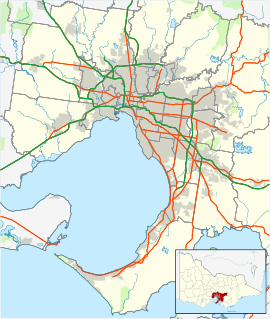Mount Cottrell is a locality in Victoria, Australia, 31 km (19 mi) west of Melbourne's Central Business District, straddling the local government areas of Melton and Wyndham. Mount Cottrell recorded a population of 496 at the 2021 census.[1]
| Mount Cottrell Melbourne, Victoria | |||||||||||||||
|---|---|---|---|---|---|---|---|---|---|---|---|---|---|---|---|
 Mount Cottrell | |||||||||||||||
 | |||||||||||||||
| Coordinates | 37°46′26″S 144°37′52″E / 37.77389°S 144.63111°E | ||||||||||||||
| Population | 496 (2021 census)[1] | ||||||||||||||
| Postcode(s) | 3024 | ||||||||||||||
| Elevation | 34 m (112 ft) | ||||||||||||||
| Location | |||||||||||||||
| LGA(s) | |||||||||||||||
| State electorate(s) | |||||||||||||||
| Federal division(s) | |||||||||||||||
| |||||||||||||||
Geography
editThe locality of Mount Cottrell consists of mainly privately owned open land. It is named after the 203m high mountain it encompasses, Mount Cottrell, the most massive of the Werribee Plains volcanoes, a volcanic cone formed by the radial eruption of numerous lava tongues. The mountain was purchased by Melton Council in 2007 to preserve the significant geological and flora and fauna values on the site.
History
editThe locality is named after Anthony Cottrell, a member of the Port Phillip association who was allotted the land by the company in about 1835–36. The original "No.10" hut was located about 1.5 km north of the Mount Cottrell summit.[2]
Mount Cottrell Post Office opened on 1 January 1866, closed in 1895, reopened in 1902 and closed again in 1958.[3]
Mount Cottrell massacre
editThe Mount Cottrell massacre was a reprisal killing for squatter Charles Franks and his convict shepherd Thomas Flinders by Aboriginal people. Around 10 Wathaurong people were murdered at Mt Cottrell by 17 settlers armed with muskets on 16 July 1836.[4][5][6]
Residential development
editThe first residential subdivision in the area, Chartwell Estate, was established in 1957 on the corner of Boundary Road and Downing Street. Blocks were sold sight unseen to English migrants, and in a bid to attract them, the estate was named after Chartwell (Winston Churchill's country house) and streets were given distinctly English names. Only a handful of houses were ever built, due to the remote location and lack of basic infrastructure.[7][8]
Much of the southern section of Mount Cottrell lies within Melbourne's urban growth boundary and is zoned for urban growth.[9] Residential development of the locality began in the early 2020s, with the area between Leakes Road and the Regional Rail Link the first to be built up.
External links
edit- "E2 Mount Cottrell - Eruption Point". Victorian Sources Online. Retrieved 5 June 2016.
References
edit- ^ a b Australian Bureau of Statistics (28 June 2022). "Mount Cottrell (Suburbs and Localities)". 2021 Census QuickStats. Retrieved 22 July 2022.
- ^ "Shire or Melton heritage study - Mount Cottrell homestead" (PDF). Melton shire council. Retrieved 29 October 2019.
- ^ Phoenix Auctions History, Post Office List, retrieved 28 March 2021
- ^ Hocking, Geoff (2013). Wyndham: Our Story. Castlemaine, Victoria: New Chum Press.
- ^ "Massacre Map Australia: The Killing Times". The Guardian. 19 July 2019. Retrieved 26 August 2019.
- ^ "Mt Cottrell, Werribee". Colonial Frontier Massacres in Australia, 1788-1930. Centre For 21st Century Humanities, University of Newcastle (Australia). Retrieved 30 June 2021.
- ^ Wong, Marcus (9 March 2020). "The ghost of Rosedale Estate in Melbourne's west". Waking up in Geelong. Retrieved 6 December 2024.
- ^ dev (27 September 2017). "Chartwell: Old Winston's aching piles ..." Noel Murphy. Retrieved 6 December 2024.
- ^ "VicPlan". Department of Transport and Planning. 12 November 2024. Retrieved 6 December 2024.
